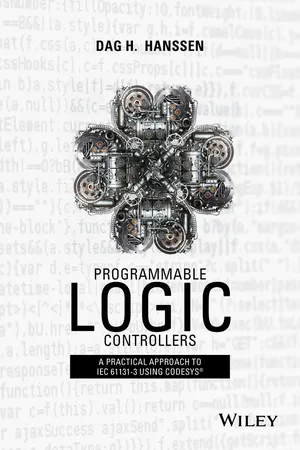
Programmable Logic Controllers
A Practical Approach to IEC 61131-3 using CoDeSys
- English
- ePUB (mobile friendly)
- Available on iOS & Android
About this book
Widely used across industrial and manufacturing automation, Programmable Logic Controllers (PLCs) perform a broad range of electromechanical tasks with multiple input and output arrangements, designed specifically to cope in severe environmental conditions such as automotive and chemical plants.
Programmable Logic Controllers: A Practical Approach using CoDeSys is a hands-on guide to rapidly gain proficiency in the development and operation of PLCs based on the IEC 61131-3 standard. Using the freely-available* software tool CoDeSys, which is widely used in industrial design automation projects, the author takes a highly practical approach to PLC design using real-world examples. The design tool, CoDeSys, also features a built in simulator/soft PLC enabling the reader to undertake exercises and test the examples.
Key features:
- Introduces to programming techniques using IEC 61131-3 guidelines in the five PLC-recognised programming languages.
- Focuses on a methodical approach to programming, based on Boolean algebra, flowcharts, sequence diagrams and state-diagrams.
- Contains a useful methodology to solve problems, develop a structured code and document the programming code.
- Covers I/O like typical sensors, signals, signal formats, noise and cabling.
- Features Power Point slides covering all topics, example programs and solutions to end-of-chapter exercises via companion website.
No prior knowledge of programming PLCs is assumed making this text ideally suited to electronics engineering students pursuing a career in electronic design automation. Experienced PLC users in all fields of manufacturing will discover new possibilities and gain useful tips for more efficient and structured programming.
* Register at www.codesys.com
www.wiley.com/go/hanssen/logiccontrollers
Frequently asked questions
- Essential is ideal for learners and professionals who enjoy exploring a wide range of subjects. Access the Essential Library with 800,000+ trusted titles and best-sellers across business, personal growth, and the humanities. Includes unlimited reading time and Standard Read Aloud voice.
- Complete: Perfect for advanced learners and researchers needing full, unrestricted access. Unlock 1.4M+ books across hundreds of subjects, including academic and specialized titles. The Complete Plan also includes advanced features like Premium Read Aloud and Research Assistant.
Please note we cannot support devices running on iOS 13 and Android 7 or earlier. Learn more about using the app.
Information
Part One
Hardware
1
About PLCs

1.1 History
- Compete on price with traditional relay controls
- Be flexible
- Withstand a harsh environment
- Be modular with respect to the number of inputs and outputs3
- Be easy to program and reprogram



Table of contents
- Cover
- Title Page
- Table of Contents
- Programmable Logic Controllers
- Preface
- Part One: Hardware
- Part Two : Methodic
- Part Three: IEC 61131-3
- Part Four: Programming
- Part Five: Implementation
- Bibliography
- Index
- End User License Agreement